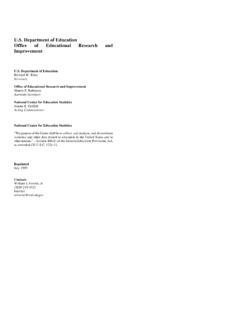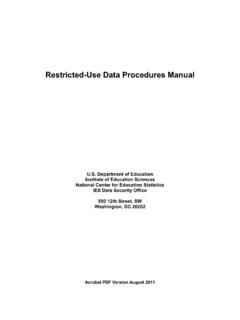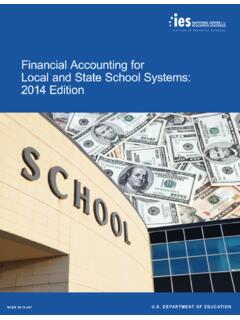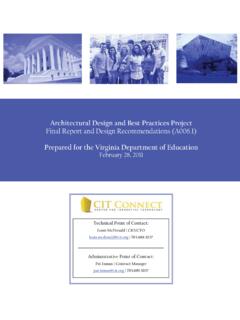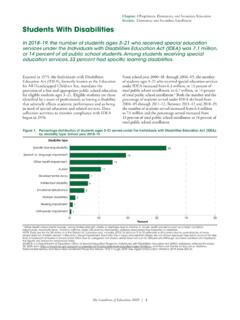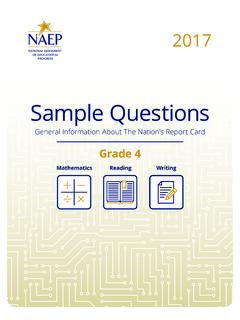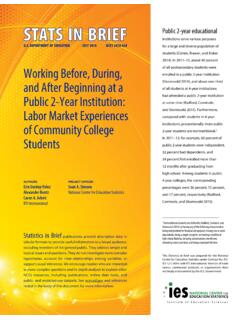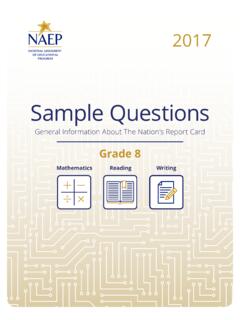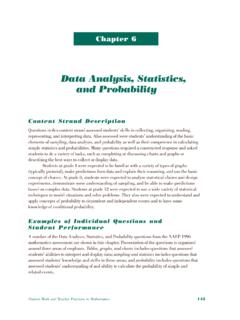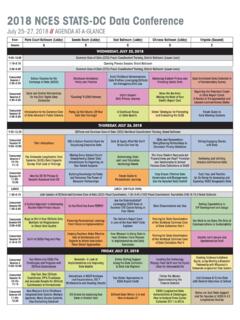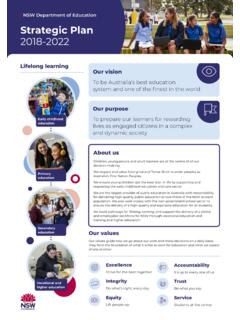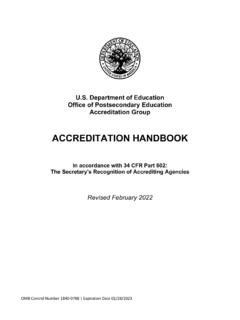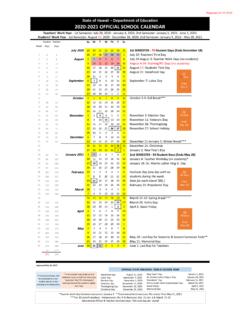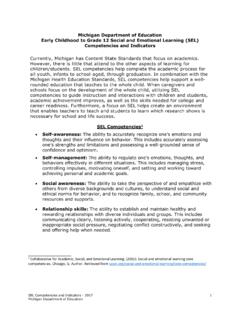Transcription of STATS IN BRIEF Higher levels of educational
1 STATS IN department OF EDUCATIONSEPTEMBER 2017 NCES 2018 009 first - generation and Continuing- generation College Students: A Comparison of High School and Postsecondary ExperiencesAUTHORSJ eremy RedfordAmerican Institutes for ResearchKathleen Mulvaney HoyerActivate Research, OFFICERJohn RalphNational center for education StatisticsStatistics in BRIEF publications present descriptive data in tabularformats to provide useful information to a broad audience, including members of the general public. They address topical issues and questions. They do not investigate more complex hypotheses, account for inter-relationships among variables, or support causal inferences. We encourage readers who are interested in more complex questions and in-depth analysis to explore other NCES resources, including publications, online data tools, and public- and restricted-use datasets.
2 See and references noted in the body of this document for more publication was prepared for NCES under Contract No. ED-IES-12-D-0002 with American Institutes for Research. Mention of trade names, commercial products, or organizations does not imply endorsement by the levels of educational attainment are associated with outcomes such as full-time employment and Higher pay for young adults. In 2013, for example, Kena et al. (2015) found that among young adults between the ages of 25 and 34 who had a full-time job, those with a bachelor s degree earned more, on average, than those with a high school diploma ($48,500 vs. $30,000). However, college attainment is unequally distributed among students. Lauff and Ingels (2013) found that among 2002 high school sophomores, 46 percent of students who had a parent with a bachelor s degree and 59 percent who had a parent with a master s degree or Higher had obtained a bachelor s degree or Higher by 2012, compared to 17 percent of students who had parents with no postsecondary education experience (or first - generation college students).
3 Student persistence through college and borrowing also varies by generation status. first - generation college students were found to be less likely than their continuing- generation peers to persist through the first couple of years of college (Lohfink and Paulsen 2005). DeAngelo and Franke (2016) examined the relationship between college readiness and college retention after the first year of college and found that the relationship between retention and generation status varies depending on college readiness. Among 21 College readiness in this study was defined as students who have a B+ or better high school GPA and have completed four years of English, three years of math, two years of a foreign language, one year each of biological and physical sciences, plus an additional year of one or the other (in total three years of science), one year of history/government, and one year of arts (DeAngelo and Franke 2016, p.)
4 1596).students identified as college-ready, first - generation college students were just as likely to return to school af ter their first year of college as their continuing- generation However, among students who were not college-ready, continuing- generation college students were more likely to return to school after their first year than first - generation college students. Furthermore, first - generation college students take out student loans more often and in Higher amounts than their continuing- generation peers in their first year of college (Furquim et al. 2017). Previous reports from the department of education s national center for education statistics (NCES) have presented findings regarding first - generation college students experiences. For instance, Warburton, Bugarin, and Nu ez (2001) found that lower percentages of first - generation college students took college entrance examinations, compared to their peers whose parents had postsecondary experience.
5 Another report examined postsecondary outcomes among 12th graders in 1992 and found a 44 percentage point difference in bachelor degree completion between first - generation college students and students with at least one parent with a bachelor s degree or a Higher level of educational attainment (24 vs. 68 percent, respectively) (Chen 2005). A more recent report found that Higher percentages of first - generation college students took remedial classes upon entering college (Chen 2016). However, updated analyses of longitudinal data are necessary to describe the experiences of first - generation college students as they transition from high school to data from a nationally representative cohort of 2002 high school sophomores, this BRIEF provides an updated look at background and educational characteristics ( , educational expectations, plans for taking the SAT/ACT,22 The SAT and ACT are college entrance examinations.)
6 And cumulative high school grade point average [GPA]), planning for college, postsecondary enrollment, and postsecondary completion patterns of two groups of students: first - generation college students and continuing- generation college students with at least one parent with a bachelor s degree or a Higher level of educational attainment. These descriptions of first - generation college students (students whose parents do not have any postsecondary education experience) offer a portrait of this important group of students and highlight variation within the group. The BRIEF also explores how postsecondary plans, attendance, and completion may vary between first - generation college students and their peers whose parents have college degrees. These comparisons indicate the extent to which first - generation college students differ from students whose parents have a bachelor s degree or a Higher level of educational attainment.
7 In addition, the BRIEF presents student-reported information regarding the reasons why some 2002 high school sophomores who were postsecondary enrollees did not obtain a credential by , METHODS, AND STRUCTURE OF THE REPORTThis statistics in BRIEF utilizes recently released data from the NCES education Longitudinal Study of 2002 (ELS:2002). ELS:2002 is a longitudinal dataset that is nationally representative of high school sophomores in 2002. Students who participated in ELS:2002 were followed through 2012, 10 years after their sophomore year in high school, with intermediary follow-ups in 2004 (when most of the students were in 12th grade) and 2006. The base-year data collection in 2002 included interviews with parents, students, and school staff, while the 2004, 2006, and 2012 follow-ups included interviews with students.
8 The analyses in this BRIEF rely on multiple sources of information from ELS:2002. Parent information is used to establish the college generation status of the student and household income. Student data are used to gauge academic expectations, college planning while in high school, educational attainment, first postsecondary institution attended, and barriers to completing a credential. High school transcript data are used to report on student GPAs. 3 Consistent with prior research, in this BRIEF , first - generation college students are defined as students whose parents both have had no postsecondary education experience and have a high school education or a lower level of educational attainment (Ishitani 2006; Chen 2005). Continuing- generation college students are defined as students who have at least one parent who had some postsecondary education experience.
9 However, this BRIEF focuses on a specific subset of continuing- generation college students, namely those who have at least one parent with a bachelor s degree or a Higher level of educational attainment. Each section of findings in the BRIEF presents both a targeted look at first - generation college students and a comparison between first - generation students and their continuing- generation peers. The report s findings are presented as responses to the three study questions outlined later in the the BRIEF focuses on comparisons between first - generation college students and a specific group of continuing- generation college students, the population of interest is 2002 high school sophomores who enrolled in a postsecondary institution by 2012. In the final section of the BRIEF , the analytic focus is narrowed to those 2002 high school sophomores who had enrolled in a postsecondary institution, but had not completed a credential by 2012, when the final ELS:2002 follow-up was comparisons highlighted in the text are statistically significant at the p <.
10 05 level. Only statistically significant differences are described in the text of this report. No adjustments were made for multiple comparisons. For additional information about p values and the data or methods used in this study, see the Methodology and Technical Notes at the end of the report. College generation StatusAs noted on page 2 of this BRIEF , an earlier NCES report identified a 44 percentage point difference in bachelor s degree completion between first - generation college students and continuing- generation college students with at least one parent with a bachelor s degree or a Higher level of educational attainment (Chen 2005). Given these large differences, the remainder of the text of the report focuses on the differences between these two those students who enrolled in postsecondary education , this BRIEF compares first - generation college students to a specific subset of continuing- generation college college students are students who enrolled in postsecondary education and whose parents do not have any postsecondary education experience.
